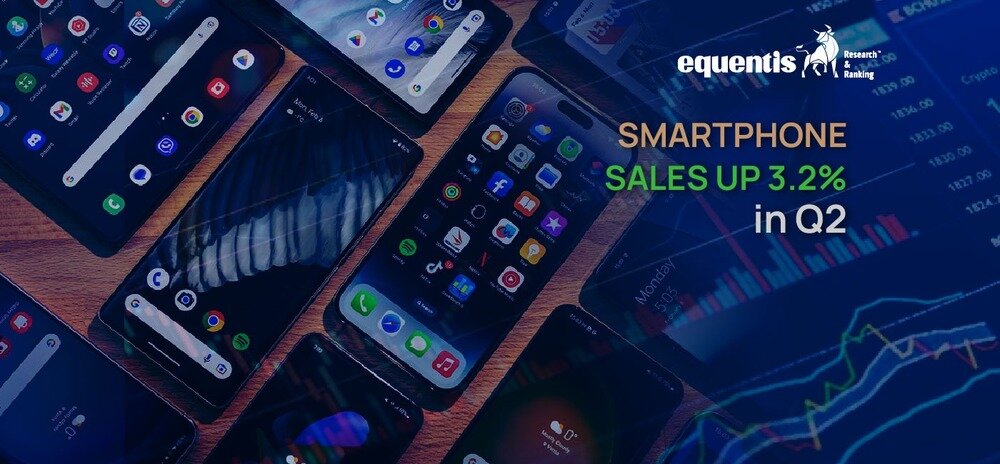Can you imagine a world without your smartphone? It’s hard to. These pocket-sized powerhouses have become our constant companions, shaping how we work, play, and connect. India’s love affair with smartphones shows no signs of cooling down. It’s heating up!
The country’s smartphone market has just clocked a sizzling 3.2% growth in Q2, with shipments reaching 35 million units. Who’s leading this digital revolution? Vivo is the undisputed champion of the overall market, while Apple reigns supreme in the coveted super-premium segment.
Let’s take a closer look at the numbers.
| Top 10 Brands of India’s Smartphone Market | |||
| Brands | Q2-2023(in%) | Q2-2024(in%) | Y-o-Y Unit Change(in %) |
| vivo | 16 | 16.5 | 6.7 |
| Xiaomi | 11 | 13.5 | 26.8 |
| Samsung | 15.7 | 12.9 | -15.4 |
| realme | 12.6 | 12.6 | 3.4 |
| OPPO | 11 | 11.5 | 7.9 |
| Apple | 5.6 | 6.7 | 24.2 |
| Motorola | 2.3 | 6.2 | 179.7 |
| Poco | 5 | 5.7 | 17 |
| OnePlus | 7.2 | 4.4 | -37.3 |
| iQOO | 2.1 | 2.7 | 31.6 |
| Others | 11.5 | 7.3 | -34.7 |
7.2% Y-oY Surge in Smartphone Sales in 1HFY24
According to the International Data Corporation (IDC), India’s smartphone shipments surged 7.2% year-over-year in the first half of 2024, reaching 69 million units. That’s not all—the second quarter alone saw a 3.2% year-over-year increase, with shipments totaling an incredible 35 million smartphones. While this marks the fourth consecutive quarter of growth, factors such as subdued consumer demand and escalating average selling prices (ASPs) have slowed the overall expansion pace.
However, the slow pace may not be the case in the second half, thanks to the festive season extending until November. Consumers will be spoilt for choice as smartphone vendors, especially Chinese manufacturers, have cleared the previous inventory and introduced new models in the mid-premium and premium segments. This move is to capitalize on the monsoon sales in July and August.
Key Trends in Selling Prices
A look at the second quarter also reveals key trends. Average selling prices increased by 2.8% year-over-year but dipped slightly quarter-over-quarter to approximately ₹20,000. The entry-level segment (below ₹8,000) experienced a sharp decline of 36% year-over-year, with its market share decreasing from 22% to 14%. In contrast, the mass budget segment (₹8,000-₹16,000) saw modest growth of 8%, capturing a slightly larger market share.
| Smartphone Segment | Q2-2023(in%) | Q2-2024(in%) | Y-o-Y Unit Change(in %) |
| Entry-Premium | 22 | 30 | 42 |
| Mid-Premium | 5 | 4 | -25 |
| Premium | 2 | 2 | -37% |
| Super-Premium | 6 | 7 | 22% |
The entry-premium segment (₹16,000-₹32,000) emerged as a star performer, registering a substantial 42% year-over-year growth and expanding its share from 22% to 30%. Brands like OPPO, Vivo, and Samsung have gained significant market share in this category. On the other hand, the mid-premium (₹32,000-₹48,000) and premium (₹48,000-₹64,000) segments faced challenges, with unit shipments declining by 25% and 37% respectively.
The super-premium segment (above ₹64,000) continued its upward trajectory, expanding by 22% and capturing a larger market share. Apple dominated this segment with an 83% share, followed by Samsung at 16%. Notably, the adoption of 5G technology accelerated, with 77% of smartphones shipped in the second quarter being 5G-enabled.
Online Sales Shoot Up from 47% to 50% Y-o-Y
Besides the selling price, the distribution landscape also changed. Online channels gained traction, increasing their share from 47% to 50% year-over-year. In contrast, offline channels faced headwinds due to the severe heatwave.
Standout Performers
So, who are the consumers going after the most? Vivo maintained its leadership position for the second consecutive quarter, bolstered by a diverse product portfolio across price segments. Motorola was impressed with its strong growth, while Nothing emerged as another standout performer.
Premium Push, 5G Challenges, AI Focus
Here’s another interesting highlight—the premiumization trend driven by Apple and Samsung is prompting Chinese brands to explore opportunities beyond the mass segment. The entry-premium segment is projected to maintain robust growth, while the entry-level segment is expected to face challenges despite efforts to introduce affordable 5G devices. Moreover, marketing smartphones equipped with generative AI capabilities will likely intensify.
Conclusion
Overall, the Indian smartphone market is characterized by dynamic shifts in consumer preferences, technological advancements, and intense competition. With the industry evolving, key players must adapt their strategies to cater to the changing needs and aspirations of Indian consumers, who can indeed look forward to exciting times in the smartphone space!
*Disclaimer Note: The securities quoted, if any, are for illustration only and are not recommendatory. This article is for education purposes only and shall not be considered as recommendation or investment advice by Research & Ranking. We will not be liable for any losses that may occur. Investment in securities market are subject to market risks. Read all the related documents carefully before investing. Registration granted by SEBI, membership of BASL, and certification from NISM in no way guarantee the performance of the intermediary or provide any assurance of returns to investors.
How useful was this post?
Click on a star to rate it!
Average rating 5 / 5. Vote count: 1
No votes so far! Be the first to rate this post.
I’m Archana R. Chettiar, an experienced content creator with
an affinity for writing on personal finance and other financial content. I
love to write on equity investing, retirement, managing money, and more.
























